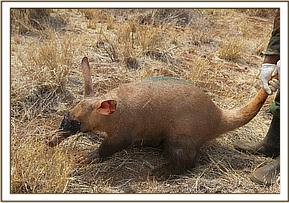EASTERN CONSERVATION AREA VETERINARY UNIT MONTHLY REPORT OCTOBER 2014 Report by: Bernard Rono INTRODUCTION In the month of October, Meru Conservation Area continued to experience a drought consequently many wildlife species were dispersed along the greener riparian habitats
EASTERN CONSERVATION AREA VETERINARY UNIT MONTHLY REPORT OCTOBER 2014
Report by: Bernard Rono
INTRODUCTION
In the month of October, Meru Conservation Area continued to experience a drought consequently many wildlife species were dispersed along the greener riparian habitats. The park has several permanent rivers which ensure water availability throughout the year, however, foliage availability is a challenge.
Cases attended included a post mortem examination of a northern white rhino carcass in Ol Pejeta Conservancy, removal of a strangulating collar from an elephant and follow up treatment of a wounded elephant in Meru national park.
CASE#1 POST MORTEM EXAMINATION OF A WHITE RHINO CARCASS
Date of Death: 10th October 2014
Date of Postmortem: 11th October 2014
Species: White Rhino
Sex: Female
Age: Adult
Location: Patas, Solio Ranch
History
On 11th October 2014 the Officer in Charge of security at Solio ranch reported a white rhino carcass in the ranch. This followed a poaching incident the previous night. A post mortem examination was carried out to document the cause death.

General examination
- Carcass was found lying on left lateral recumbency. The mammary glands, right ear pinna and the right commissure of the lips had been eaten by scavengers
- Both horns were retrieved and held in custody by the officer in charge
- There was a penetrating wound measuring one (1) centimeter in diameter through the muscles of the left os humerus into the chest through the third intercostal space. A similar wound was found on the right os humerus
Massive hemorrhage was found in thoracic cavity with clotted blood. There were penetrating wounds in the left apical lobes of the lung and the right apical lobe of the lung. All other organs were normal.


A fully formed male fetus was found in the uterus approximately 14 month gestation.

Conclusion
This rhino died from hypovolemic shock caused by injuries to the lungs. These injuries are consistent with those caused by a high velocity projectile fired from close range. The projectile seems to have entered through the right side of the body and exit from contralateral left chest which showed a larger wound.
CASE #2 COLLAR REMOVAL IN AN ELEPHANT
Species: Elephant
Age: Adult
Sex: Male
Location: Kindani Plains, Meru National Park
Date: 13th October 2014
History
This elephant bull had a tight strangulating collar around its neck which had caused wounds on its nape. It was also in poor body condition compared to its herd mates. This animal was reported initially by tourists who photographed it in mid-September and it was immobilized for treatment on the 13th October when the veterinary team found it during their routine patrol of the park.


Immobilization, examination and treatment
Routine elephant immobilization procedure was followed. A 3cc Dan inject dart containing 18mg Etorphine Hcl was administered to the gluteal muscles and the elephant was immobilized after 12 minutes, falling onto right lateral recumbency.
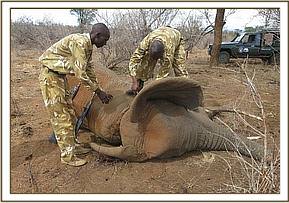

Close examination showed an old collar which may have been fitted when this animal was young. Treatment entailed collar removal and cleaning the wounds with antiseptic. Parenteral antimicrobials and multivitamin drugs were administered.
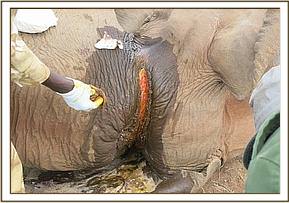

Reversal
To reverse the effects of anesthesia Diprenophine hydrochloride 60mg was administered intravenously through the ear veins.
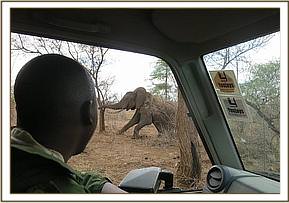

Prognosis
He is expected to make a full recovery.
CASE #3 WOUND TREATMENT IN A JUVENILE ELEPHANT
Species: Elephant
Age: Juvenile
Sex: Male
Location: Kinna, Meru National Park
Date: 13th October 2014
This was a follow up treatment on a three year old male elephant that suffered an expansive wound on its right thigh suspected to have been caused by a predator attack. He was immobilized for treatment on October 13th.
Immobilization, examination and treatment
A dart containing 3mg Etorphine Hcl was used to immobilize this elephant and he fell onto left lateral recumbency after 5 minutes. He was darted on foot after stalking it close to a river.
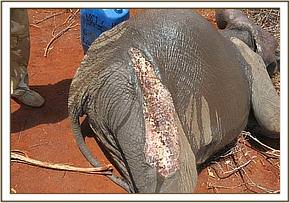

Examination revealed that the wound was showing signs of healing by secondary intention with fibrous tissue formation. The wound was cleaned with water and soap and then Povidone Iodine and green clay was applied. Betamox trihydrate 30ml was injected intramuscularly to prevent overwhelming systemic infection.
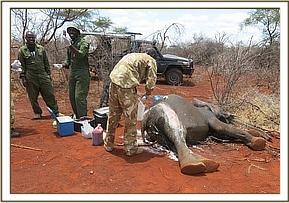

Reversal
Reversal from anesthesia was achieved by administration of Diprenophine HCl 18mg through the ear vein.


CASE#4 POST MORTEM EXAMINATION OF A NORTHERN WHITE RHINO
Date of Death: 17th October 2014
Date of Postmortem: 18th October 2014
Species: Northern White Rhino - Suni
Sex: Male
Age: Adult, 34 years
Location: Ol Pejeta
History
This report describes findings of a post mortem examination on a northern white rhino carcass in Ol Pejeta conservancy. This procedure was conducted on site after an estimated 12 hour delay from time of death to rule out anthrax – a notifiable disease of public health importance.
Suni, a male northern white rhino (NWR) was found dead by rangers in its boma in Ol Pejeta conservancy (OPC) on Friday, October 17. He had no recent history of illness and had been observed grazing the previous night.
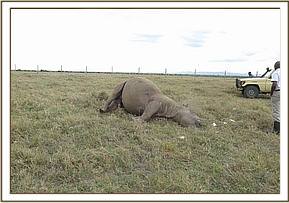

Suni and three other NWR (1 male, 2 females) were moved to OPC in 2009.
General examination
- General observation showed a carcass in good body condition. Blood tinged froth exuded from the nostrils and the carcass was excessively bloated. Evidence of struggle was noted at the scene
- Blood smear stained with methylene blue was negative for Bacillus anthracis
- There were subcutaneous hematomas along the lumbar vertebrae
- Systemic examination showed autolysis of internal organs due to high ambient temperature, however, the following changes were observed:
- Blood tinged froth at the tracheal bifurcation and the bronchi
- The heart was generally collapsed with little coagulated blood, the pericardial fluid was blood tinged
- Insignificant congestion of mesenteric blood vessels in stomach and intestinal serosa
Incidental finding: parasitic cyst 5 centimeters in diameter was found in the pleura.
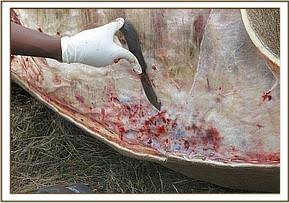

Samples collected
Efforts were made to collect spermatozoa at post mortem for future NWR breeding plans. This entailed excision of testicles by aseptic technique and flushing the epididymis with a sterile isotonic solution to collect spermatozoa for analysis (sperm count, motility, morphology and eosin/ nigrosin staining for viability)
Observation under a microscope showed 50% live immotile spermatozoa with normal morphology. For storage cryoprotectant media was added and aliquoted into straws. This mixture was frozen using a method known as vitrification and cryopreserved in liquid nitrogen for future use.


- Tissue samples for toxicology were preserved in a freezer for further investigation:
- Gastrointestinal contents were collected from various sections of the gut
- Sections of stomach and intestinal wall
- Sections of liver and kidney
- Genetic tissue samples for RHODIS database
Conclusion
Sudden death of this rhino was attributed to a confluence of natural causes.
Organic conditions such as botulism caused by ingestion of preformed toxins of Clostridium botulinum bacteria which may cause sporadic death in wildlife with no pathological lesions need to be investigated. Ingested toxins of Cl. botulinum are neurotoxins which may be present in decaying plant or animal material cause flaccid motor paralysis which leads to respiratory, cardiac and gut paralysis. Confirmatory diagnosis in such a case is by demonstration of botulinum toxin in tissues, stomach and intestinal contents of the carcass.
Other causes of sudden death which need to be investigated include Clostridium perfrigens enterotoxaemia which is characterized by a peracute clinical course and mortality. This disease has recently been reported in black rhinos in Ol Jogi conservancy (Ndeereh et al., 2011).
CASE#5 RESCUE AND TREATMENT OF AN INJURED AARDVARK
Species: Aardvark
Age: Adult
Sex: Unknown
Location: ?
Date: 19th October 2014
History
This injured aardvark was found one morning by the community living around the park.


Immobilization, examination and treatment
Net capture method was used for restraint. Examination showed wounds caused by sharp objects to its head. These wounds were cleaned and a topical antimicrobial applied.
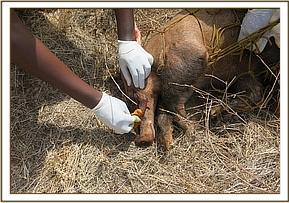

Prognosis
It was rescued and released into the park on October 19th and expected to make a full recovery.
